Designing Translingual and Transmodal Scaffolding and VR Pair Programming for Supporting Multilingual Learners’ Participation in Scientific Sensemaking
Abstract
1. Introduction
- Q1: How did the teacher use translingual and transmodal scaffolding to support ML students’ participation and talk?
- Q2: How did MLs and EMLs participate in scientific sensemaking through the intentional translingual and transmodal scaffolding design of the unit, including the VR pair programming activity and teacher scaffolding?
2. Literature Review
2.1. Translingual and Transmodal Scaffolding
2.2. Affordances of Immersive Virtual Reality to Support Science Learning
2.3. Supporting Group Participation Through the Pair Programming Strategy
3. Materials and Methods
3.1. Research Design and Participants
3.2. The Focal Science Unit
3.3. The Translingual and Transmodal Scaffolds
3.4. VR Pair Programming Activity
3.5. Data Sources
3.6. Data Analysis
4. Results
4.1. RQ1: The Teacher’s Translingual and Transmodal Scaffolding for Supporting MLs’ Participation and Talk
4.2. RQ2: MLs and EMLs’ Overall Participation and Quality of Talk
4.3. RQ2: MLs and EMLs’ Participation and Talk During Different Scaffolded Activities
- Elle:
- OK, our essential questions, number one, which everyday objects should we not mix together to avoid making a mess at home?
- James:
- (raised hand, and Elle called on him) Elephant toothpaste.
- Elle:
- OK, what gets mixed together to make elephants toothpaste.
- James:
- I know it was like, carbon dioxide and something!
- Elle:
- OK. Right now we’re just, we’re being scientists right now. We’re just having a hypothesis, an educated guess.
- Elle:
- So let’s review the procedure sheet and some diagram examples…. Who can read the anchoring phenomenon? You can read it in English or Espanol. We’re looking at this paper right here. Okay. Will you read it, Nancy?
- Nancy:
- How even when heating, cooling or mixing substances, the total weight of matter is converse, conserved.
- Elle:
- Conserved. What does conserved mean?
- Alonso:
- It’s still the same.
- Elle:
- Step #2 who can read that? Go ahead. (picked someone, and the student read the question). OK, so physically or chemically, can anyone translate that?
- Alonso:
- fisical y quimical (physical and chemical).
- Elle:
- Can you read the whole thing like como cambiaran Ingrediente a ingrediente durante la reacción. (Elle tries to read the text in Spanish).
- Alonso:
- Como cambiara el ingrediente durante la reacción (how will the ingredient change during the reaction).
5. Discussion and Conclusions
5.1. Translingual and Transmodal Scaffolding Supports Equal Participation of MLs and EMLs
5.2. Active Participation Did Not Necessarily Lead to High Quality Science Talk
5.3. ML and EMLs’ Talk During Scientific Sensemaking Through the Translingual and Transmodal Scaffolding Design
5.4. Implications and Recommendations
5.5. Conclusions and Limitations
Author Contributions
Funding
Institutional Review Board Statement
Informed Consent Statement
Data Availability Statement
Acknowledgments
Conflicts of Interest
Abbreviations
| EML | English monolingual learner |
| VR | Virtual reality |
| ML | Multilingual learner |
References
- Abtahi, Y., Graven, M., & Lerman, S. (2017). Conceptualising the more knowledgeable other within a multi-directional ZPD. Educational Studies in Mathematics, 96(3), 275–287. [Google Scholar] [CrossRef]
- Achieve. (2017). Using phenomena in NGSS-designed lessons and units. Achieve. [Google Scholar]
- Adžgauskaitė, M., Abhari, K., & Pesavento, M. (2020). How virtual reality is changing the future of learning in K-12 and beyond: Using the needs-affordances-features perspective. In C. Stephanidis, D. Harris, W.-C. Li, D. D. Schmorrow, C. M. Fidopiastis, P. Zaphiris, A. Ioannou, X. Fang, R. A. Sottilare, & J. Schwarz (Eds.), HCI international 2020—Late breaking papers: Cognition, learning and games (Vol. 12425, pp. 279–298). Springer International Publishing. [Google Scholar] [CrossRef]
- Canagarajah, S. (2018). Translingual practice as spatial repertoires: Expanding the paradigm beyond structuralist orientations. Applied Linguistics, 39(1), 31–54. [Google Scholar] [CrossRef]
- Celic, C. M., & Seltzer, K. (2013). Translanguaging a CUNY-NYSIEB guide for educators. CUNY-NYSIEB. [Google Scholar]
- Cenoz, J., & Gorter, D. (2020). Pedagogical translanguaging: An introduction. System, 92, 102269. [Google Scholar] [CrossRef]
- Cohen, E. G., & Lotan, R. A. (2014). Designing groupwork: Strategies for the heterogeneous classroom (2nd ed.). Teachers College Press. [Google Scholar]
- Daniel, S. M., Jiménez, R. T., Pray, L., & Pacheco, M. B. (2019). Scaffolding to make translanguaging a classroom norm. TESOL Journal, 10(1), e00361. [Google Scholar] [CrossRef]
- Ding, A.-C. E. (2023). Examining the affordances of virtual reality for supporting English learners’ science learning: A multimodal perspective. Available online: https://www.researchgate.net/publication/370105031 (accessed on 21 May 2025).
- Ding, A.-C. E. (2024). Empowering multilingual learners through translingual and transmodal practices in virtual learning spaces. Available online: https://www.proquest.com/scholarly-journals/empowering-multilingual-learners-through/docview/3115807595/se-2 (accessed on 21 May 2025).
- Ding, A.-C. E., & Cha, E. E. (2024). The integration of virtual reality-enhanced multimodal meaning-making improves knowledge acquisition and disciplinary literacy development in science classrooms. Learning and Instruction, 94, 101999. [Google Scholar] [CrossRef]
- Ding, A.-C. E., Shi, L., Lee, I. H., Demirata, A., Cha, E., Zhu, Z., & Yang, H. (2025). Investigating the impact of learning modes and instructional sequences of VR-integrated station activities on science learning from the multimodal perspective [Unpublished manuscript].
- Fackler, A. K., Adah Miller, E., & Li, T. (2024). Promoting meaningful and equitable modeling practices: Developing agency, using diverse ways of knowing, and collaborating to build knowledge through modeling practices. Science and Children, 61(1), 25–31. [Google Scholar] [CrossRef]
- Fan, G., Liu, D., Zhang, R., & Pan, L. (2025). The impact of AI-assisted pair programming on student motivation, programming anxiety, collaborative learning, and programming performance: A comparative study with traditional pair programming and individual approaches. International Journal of STEM Education, 12(1), 16. [Google Scholar] [CrossRef]
- Froehlich, F., Hovey, C., Reza, S., & Plass, J. L. (2024, March 16–21). Beyond slideshows—Investigating the impact of immersive virtual reality on science learning. 2024 IEEE Conference on Virtual Reality and 3D User Interfaces, VR 2024 (pp. 945–950), Orlando, FL, USA. [Google Scholar] [CrossRef]
- Fusaro, M., Lisi, M. P., Era, V., Porciello, G., Candidi, M., Aglioti, S. M., & Boukarras, S. (2025). The transformative power of virtual reality: Redefining interactions in virtual platforms, education, healthcare, and workplaces. Topoi, 1–16. [Google Scholar] [CrossRef]
- García, O. (2017). Translanguaging in schools: Subiendo y Bajando, Bajando y subiendo as afterword. Journal of Language, Identity & Education, 16(4), 256–263. [Google Scholar] [CrossRef]
- García, O., & Wei, L. (2014). Translanguaging: Language, bilingualism and education. Palgrave Macmillan. [Google Scholar] [CrossRef]
- Grapin, S. E., Pierson, A., González-Howard, M., Ryu, M., Fine, C., & Vogel, S. (2023). Science education with multilingual learners: Equity as access and equity as transformation. Science Education, 107(4), 999–1032. [Google Scholar] [CrossRef]
- He, P. E., & Lin, A. M. (2022). Translanguaging, trans-semiotizing, and trans-registering in a culturally and linguistically diverse science classroom. Sociocultural Explorations of Science Education, 27, 143–171. [Google Scholar] [CrossRef]
- Jensen, B., & Thompson, G. A. (2019). Equity in teaching academic language—An interdisciplinary approach. Theory Into Practice, 59(1), 1–7. [Google Scholar] [CrossRef]
- Jewitt, C., Kress, G., Ogborn, J., & Tsatarelis, C. (2001). Exploring learning through visual, actional, and linguistic communication: The multimodal environment of a science classroom. Educational Review, 53(1), 5–18. [Google Scholar] [CrossRef]
- Jiang, L., Li, Z., & Leung, J. S. C. (2024). Digital multimodal composing as translanguaging assessment in CLIL classrooms. Learning and Instruction, 92, 101900. [Google Scholar] [CrossRef]
- Johnson, D. W., & Johnson, R. T. (2009). An educational psychology success story: Social interdependence theory and cooperative learning. Educational Researcher, 38(5), 365–379. [Google Scholar] [CrossRef]
- Kress, G. (2009). Multimodality: A social semiotic approach to contemporary communication. In Multimodality: A social semiotic approach to contemporary communication. Routledge Taylor & Francis Group. [Google Scholar] [CrossRef]
- Langeloo, A., Lara, M. M., Deunk, M. I., & Bosker, R. J. (2021). Profiles of learning opportunities of multilingual and monolingual children in kindergarten. European Journal of Psychology of Education, 36(2), 379–404. [Google Scholar] [CrossRef]
- Lemmi, C., & Pérez, G. (2024). Translanguaging in elementary science. International Journal of Science Education, 46(1), 1–27. [Google Scholar] [CrossRef]
- MacDonald, R., Cook, H. G., & Miller, E. C. (2014). Doing and talking science: A teacher’s guide to meaning-making with English learners. Board of Regents of the University of Wisconsin System. [Google Scholar]
- Miller, E., & Reigh, E. (2020). Interactional approach to language: Supporting all students to engage in equitable sensemaking. In M. Gresalfi, & I. S. Horn (Eds.), The interdisciplinarity of the learning sciences: 14th International Conference of the Learning Sciences (ICLS) 2020 (Vol. 2, pp. 923–924). International Society of the Learning Sciences. [Google Scholar]
- Mills, K. A., Scholes, L., & Brown, A. (2022). Virtual reality and embodiment in multimodal meaning Making. Written Communication, 39(3), 335–369. [Google Scholar] [CrossRef]
- Mina, L. W. (2021). A transmodal framework for teaching multimodal composing practices to multilingual students. In Plurilingual pedagogies for multilingual writing classrooms (pp. 45–57). Routledge. [Google Scholar] [CrossRef]
- Moje, E. B. (2015). Doing and teaching disciplinary literacy with adolescent learners: A social and cultural enterprise. Harvard Educational Review, 85(2), 254–278. [Google Scholar] [CrossRef]
- Monteiro, A. K., Cheyne, M., & Kline, L. (2024). Fostering inclusive collaboration: Strategies to disrupt inequities in student groupwork. The Science Teacher, 91(3), 68–75. [Google Scholar] [CrossRef]
- National Science Teaching Association. (2025). Sensemaking. National Science Teaching Association. Available online: https://www.nsta.org/sensemaking (accessed on 21 May 2025).
- Newfield, D. (2017). Transformation, transduction and the transmodal moment. In C. Jewitt (Ed.), The Routledge handbook of multimodal analysis (2nd ed., pp. 100–113). Routledge. [Google Scholar]
- NGSS Lead States. (2013). Next generation science standards: For states, by states. The National Academies Press. Available online: https://nap.nationalacademies.org/catalog/18290/next-generation-science-standards-for-states-by-states (accessed on 21 May 2025).
- Parong, J., & Mayer, R. E. (2021). Cognitive and affective processes for learning science in immersive virtual reality. Journal of Computer Assisted Learning, 37(1), 226–241. [Google Scholar] [CrossRef]
- Pérez Fernández, L. M. (2024). Translanguaging in multilingual classrooms. In Translanguaging in multicultural societies (pp. 93–107). Palgrave Macmillan. [Google Scholar] [CrossRef]
- Prain, V., & Tytler, R. (2022). Theorising learning in science through integrating multimodal representations. Research in Science Education, 52(3), 805–817. [Google Scholar] [CrossRef]
- Safford, K., Tugli, F. M., Shah, S., Mukherjee, S. J., Ashour, S., Mukorera, M., & Buckler, A. (2017). Multilingual classrooms: Opportunities and challenges for English medium instruction in low and middle income contexts. Available online: www.educationdevelopmenttrust.com (accessed on 21 May 2025).
- Satar, M., Aranha, S., Cavalari, S. M. S., & Almijiwl, W. (2024). Low proficiency level learners’ translingual and transmodal practices in teletandem: Challenging the separation of languages principle. System, 120, 103187. [Google Scholar] [CrossRef]
- Saye, J. W., & Brush, T. (2002). Scaffolding critical reasoning about history and social issues in multimedia-supported learning environments. Educational Technology Research and Development, 50(3), 77–96. [Google Scholar] [CrossRef]
- Schwarz, C., Passmore, C., & Reiser, B. J. (2017). Helping students make sense of the world using next generation science and engineering practices. National Science Teachers Association. [Google Scholar]
- Seedhouse, E. (2022). Presence within the virtual reality environment of the international space station. Virtual Reality, 26(3), 1145–1153. [Google Scholar] [CrossRef]
- Stoeckel, M. R. (2024). Using group roles to promote collaboration. The Science Teacher, 91(6), 73–77. [Google Scholar] [CrossRef]
- Su, Y. S., Wang, S., & Liu, X. (2024). Using epistemic network analysis to explore primary school students’ computational thinking in pair programming learning. Journal of Educational Computing Research, 62(2), 339–373. [Google Scholar] [CrossRef]
- Tang, K. S., Delgado, C., & Moje, E. B. (2014). An integrative framework for the analysis of multiple and multimodal representations for meaning-making in science education. Science Education, 98(2), 305–326. [Google Scholar] [CrossRef]
- Tardy, C. (2004). The role of English in scientific communication: “Lingua franca” or “tyrannosaurus rex”? Journal of English for Academic Purposes, 3(3), 247–269. [Google Scholar] [CrossRef]
- Turner, E., Dominguez, H., Maldonado, L., & Empson, S. (2013). English learners’ participation in mathematical discussion: Shifting positionings and dynamic identities. Journal for Research in Mathematics Education, 44(1), 199–234. [Google Scholar] [CrossRef]
- Vaismoradi, M., Turunen, H., & Bondas, T. (2013). Content analysis and thematic analysis: Implications for conducting a qualitative descriptive study. Nursing & Health Sciences, 15(3), 398–405. [Google Scholar] [CrossRef]
- Wei, L. (2024). Transformative pedagogy for inclusion and social justice through translanguaging, co-learning, and transpositioning. Language Teaching, 57(2), 203–214. [Google Scholar] [CrossRef]
- Wei, X., Lin, L., Meng, N., Tan, W., Kong, S. C., & Kinshuk. (2021). The effectiveness of partial pair programming on elementary school students’ computational thinking skills and self-efficacy. Computers & Education, 160, 104023. [Google Scholar] [CrossRef]
- Williams, L., Wiebe, E., Yang, K., Ferzli, M., & Miller, C. (2002). In support of pair programming in the introductory computer science course. Computer Science Education, 21(1), 197–212. [Google Scholar] [CrossRef]
- Wood, D., Bruner, J. S., & Ross, G. (1976). The role of tutoring in problem solving. Journal of Child Psychology and Psychiatry, 17(2), 89–100. [Google Scholar] [CrossRef] [PubMed]
- Xu, F., & Correia, A. P. (2024). Adopting distributed pair programming as an effective team learning activity: A systematic review. Journal of Computing in Higher Education, 36(2), 320–349. [Google Scholar] [CrossRef] [PubMed]
- Yin, R. K. (2003). Case study research: Design and methods (3rd ed.). SAGE Publications. [Google Scholar]
- Zangori, L., & Forbes, C. T. (2016). Development of an empirically based learning performances framework for third-grade students’ model-based explanations about plant processes. Wiley Online Library, 100(6), 961–982. [Google Scholar] [CrossRef]
- Zangori, L., Peel, A., Kinslow, A., Friedrichsen, P., & Sadler, T. D. (2017). Student development of model-based reasoning about carbon cycling and climate change in a socio-scientific issues unit. Journal of Research in Science Teaching, 54(10), 1249–1273. [Google Scholar] [CrossRef]
- Zheng, H., Pacheco, M. B., & Brown, J. C. (2025). Enhancing multilingual participation in science practices through language scaffolding. Language and Education, 39(2), 512–530. [Google Scholar] [CrossRef]
- Zhu, G., & Lin, F. (2024). Teachers scaffold student discourse and emotions in knowledge building classrooms. Interactive Learning Environments, 32(7), 3279–3296. [Google Scholar] [CrossRef]

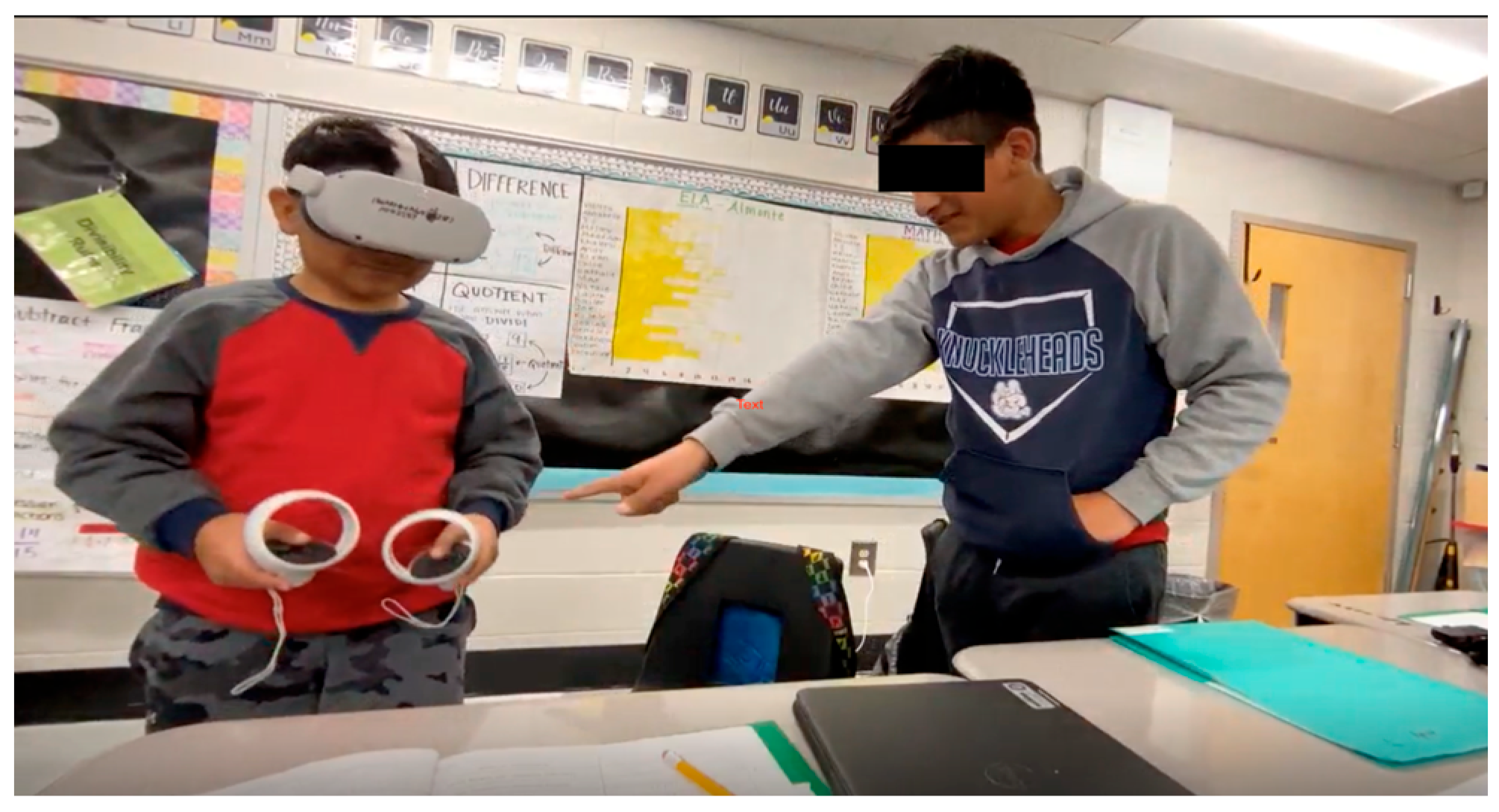
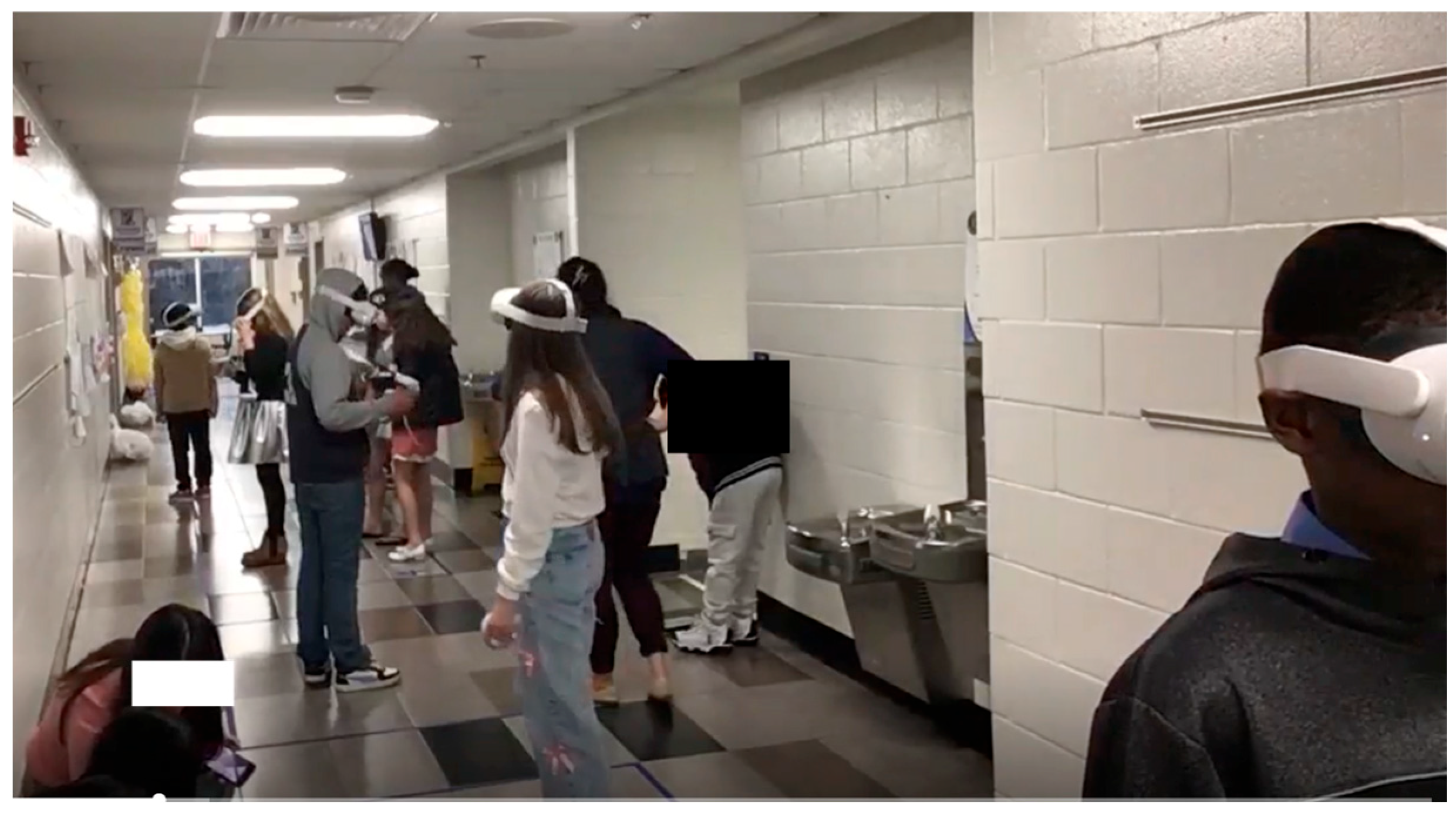
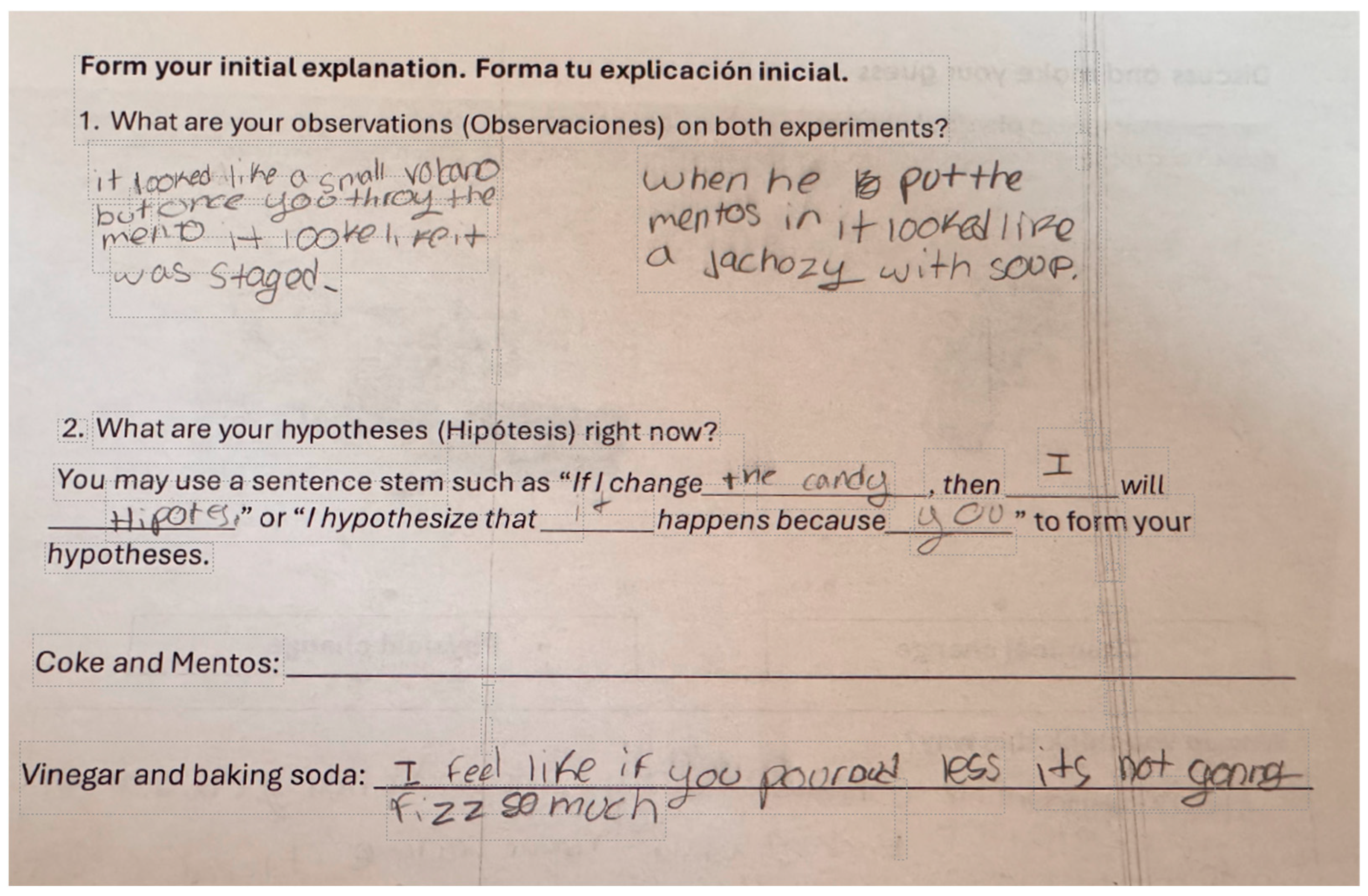
| Session Number | Learning Activities |
|---|---|
| 1 |
|
| 2 |
|
| 3 |
|
| 4 |
|
| 5 |
|
| 6 |
|
| 7 |
|
| 8 |
|
| Hard Scaffolds | Features | Examples |
| Bilingual Vocabulary Teaching | The teacher provided opportunity for whole classroom engagement in translation of the relevant terminology using translanguaging strategies to teach vocabulary in English and Spanish. | Elle: In English, the next one is atom. All students: atom. Elle: Como se dice? Alonso: átomo. Elle: átomo? All students: átomo. |
| Multimodal Representation Poster | This poster utilized transmodaling to demonstrate the various modes students could use to respond to problems and questioning during the unit. | 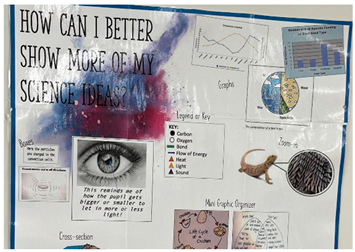 |
| Multimodal Vocabulary Wall | A poster for students to share words that can be used to describe properties of an object/phenomenon; students were encouraged to share words in English or Spanish using transmodal scaffolding strategies. | 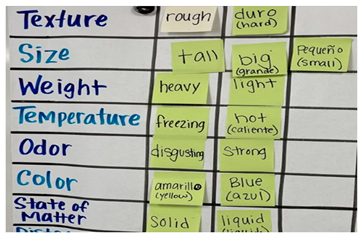 |
| Sentence Stems | Sentence stems as optional resources for students to use to develop their scientific writing. |
|
| Activity Worksheets | Worksheets created to intentionally encourage students’ translingual and transmodal practices in the unit. This includes the Pair-Programming practice worksheet, Bi-lingual Playdough Modeling activity worksheet, data collection worksheets during station activities and the CER writing worksheets | 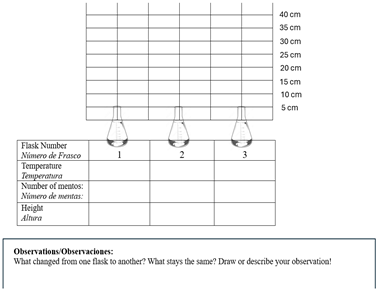 |
| Soft Scaffolds | Features | Examples |
| Teacher Discourse Moves | A list of bilingual discourse moves provided by the research team for teachers to support one of the seven functions during conversations: (1) help a student clarify his/her thinking, (2) make ideas and thinking public, (3) mark a particular idea, (4) help students listen carefully and think about other’s ideas, (5) help students deepen their reasoning, (6) help students apply their thinking to other’s ideas, and (7) help students translanguaging and honoring students’ cultural knowledge. | Elle: OK. So do you think that there’s some sort of reaction happening inside of that? Do you think there’s a reaction happening in there? Other student: I think it might be a physical or chemical reaction… |
| Student Discourse Moves | A list of bilingual discourse moves provided by the research team for students to engage in meaningful science talk with each other during group work. | Tell or explain an idea: “I know it will work because ________.”
|
| Teacher Questioning | The most frequently utilized discourse move used to engage students during whole class discussion. The question functions not on the teacher discourse moves prompts are listed under this category. | Elle: And we kind of have already been talking about that, right? About how what, what 2 substances have we mixed together that make a new substance? Alonso: Vinegar and baking soda. Elle: Vinegar and Baking soda, yes, that creates what? Alonso: A chemical. Elle: It’s a chemical reaction. What new substance do we get? Alonso: Carbon dioxide. Elle: Carbon dioxide, Good. |
| Teacher elicits student contribution | The teacher prompted students to read the worksheets in English or Spanish for participation in the class conversation. The elicited student output is only the repeating of the materials. | Elle: All right, the third bullet. Who can read the last one under “think about”? One more volunteer. All right, [Student E]. Other student: Whether or not mixing two or more substances makes a new substance. |
| Code Name | Definition | Examples |
|---|---|---|
| Interaction Types | ||
| Teacher-whole-class | The interactions involve the teacher standing in the front, addressing the whole class without directing to specific students. | Elle: Your hypothesis should say something like, I hypothesize that ______ happens because ______. Use the sentence stems. |
| Pair or small groups | Two or more students interact with one another during pair or small group work. | Dominque: ¿Cómo se dice (use pencil to point to one discourse move), Alonso: Coca Cola, Espuma (geyser)? |
| Teacher-student | The teacher interacts with specific students during pair, small group, or individual practice time. | Elle: Do you know which one is carbon and which one is oxygen? Morene: Carbon? Elle: So, look at the board, how many carbons do we have? |
| Participation Levels | ||
| Active | The student initiates the discussion or leads the task within the group. The student frequently shares ideas and opinions, asks questions, or clarifies concepts. The student actively listens to others and builds on others’ contributions. | Dominique asks Alonso: “ ¿qué opinas de la número cuatro?” (What do you thinking about number four?) “ “¿tú piensas que es physical?” (Do you think it is physical?) |
| Contributing | The student participates occasionally with relevant comments or questions. The student contributes ideas when prompted or asked directly. The student listens attentively to group discussions. | [Following Dominique’s question above] (Alonso looks down on his paper) Alonso: esperate (wait) Alonso: (responds in Spanish saying “C”) |
| Passive | The student primarily listens to others without actively contributing. The student participates minimally, like nodding or agreeing with others. The student may not be fully engaged in the group discussion or task. | Elle to the whole class: We are going to walk through one of these (writing tasks) together. It says through the Coke and candies experiment. I would say that if we mix Coke and ______ together, we will make a mess at home. What could we put in that first blank? OTHER STUDENT: 13:44 Mentos. (Marissa and Morene did not mouth the word, but they were writing) |
| Non-Participant | The student appears disengaged or withdrawn from the group. The student does not actively participate in discussions or group activities and may be doing something else. | Elle: I am going to pause you there, ask you to fill in the next sentence with the word…. Other Student: Oh, in the model, it showed that there is no change to the particles (Alonso was staring blankly; Dominique was yawning without looking at the other student) |
| Talk Quality | ||
| Specialized | The student uses specialized science vocabulary (e.g., physical and chemical change, carbon dioxide, observation, inference, height, centimeters) that was specifically introduced in the unit to explain a concept or engage in a science practice. | (kids doing the Baking soda and vinegar experiment) Nancy: What’s the height for #2? (Morene took the meterstick, bended down and did the measurement of the height) Morene: about 7 Nancy: 7? 7 inches? Morene: Centimeters |
| Relevant-Verbal | The student uses plain words to explain a concept or engage in a science practice. | (kids working on the steps of scientific method puzzle in the VR) Marissa: Yeah. Get the question one, and put a number one. James: Get question and put number one where Marissa: Get one of the plates that says question, and put it on the number one. |
| Relevant-Nonverbal | The student makes sense of a concept through non-verbal actions or performs a science practice. | See Morene’s non-verbal actions in the “specialized” example. |
| Irrelevant | The student’s talk was irrelevant to the focus of the unit. | (Kids working on creating a model to represent chemical change using play-dough) Marissa: This is how I make tortilla (shows the flat play-dough to Alonso and Morene) |
| Pair | Student Name | Active | Contributing | Passive | Non-Participant | Total |
|---|---|---|---|---|---|---|
| Pair 1 | Alonso (ML) | 134 | 90 | 57 | 14 | 295 |
| 45.4% | 30.5% | 19.3% | 4.7% | 100% | ||
| Dominique (ML) | 111 | 44 | 89 | 21 | 265 | |
| 41.9% | 16.6% | 33.59% | 7.9% | 100% | ||
| Pair 2 | Marissa (ML) | 89 | 58 | 80 | 12 | 239 |
| 37.2% | 24.3% | 33.5% | 5.0% | 100% | ||
| Morene (EML) | 102 | 58 | 72 | 6 | 238 | |
| 42.9% | 24.37% | 30.3% | 2.5% | 100% | ||
| Pair 3 | James (EML) | 63 | 45 | 37 | 2 | 147 |
| 42.9% | 30.6% | 25.2% | 1.7% | 100% | ||
| Nancy (EML) | 50 | 39 | 43 | 8 | 140 | |
| 35.7% | 27.9% | 30.7% | 5.7% | 100% |
| Pair | Student Name | Specialized | Relevant-Verbal | Relevant-Non-Verbal | Irrelevant | Total |
|---|---|---|---|---|---|---|
| Pair 1 | Alonso (ML) | 60 | 106 | 48 | 19 | 233 |
| 25.8% | 45.5% | 20.6% | 8.1% | 100% | ||
| Dominique (ML) | 17 | 67 | 91 | 15 | 190 | |
| 8.9% | 35.3% | 47.9 | 7.9% | 100% | ||
| Pair 2 | Marissa (ML) | 28 | 69 | 48 | 15 | 160 |
| 17.5% | 43.1% | 30% | 9.4% | 100% | ||
| Morene (EML) | 33 | 71 | 55 | 20 | 179 | |
| 18.4% | 39.7% | 30.7% | 11.2% | 100% | ||
| Pair 3 | James (EML) | 37 | 39 | 29 | 13 | 118 |
| 31.4% | 33.1% | 24.5% | 11% | 100% | ||
| Nancy (EML) | 33 | 41 | 34 | 10 | 118 | |
| 28% | 34.7% | 28.8% | 8.5% | 100% |
Disclaimer/Publisher’s Note: The statements, opinions and data contained in all publications are solely those of the individual author(s) and contributor(s) and not of MDPI and/or the editor(s). MDPI and/or the editor(s) disclaim responsibility for any injury to people or property resulting from any ideas, methods, instructions or products referred to in the content. |
© 2025 by the authors. Licensee MDPI, Basel, Switzerland. This article is an open access article distributed under the terms and conditions of the Creative Commons Attribution (CC BY) license (https://creativecommons.org/licenses/by/4.0/).
Share and Cite
Ding, A.-C.E.; Hernandez Cervantes, J.; Martin, K.; Zhang, K. Designing Translingual and Transmodal Scaffolding and VR Pair Programming for Supporting Multilingual Learners’ Participation in Scientific Sensemaking. Educ. Sci. 2025, 15, 1236. https://doi.org/10.3390/educsci15091236
Ding A-CE, Hernandez Cervantes J, Martin K, Zhang K. Designing Translingual and Transmodal Scaffolding and VR Pair Programming for Supporting Multilingual Learners’ Participation in Scientific Sensemaking. Education Sciences. 2025; 15(9):1236. https://doi.org/10.3390/educsci15091236
Chicago/Turabian StyleDing, Ai-Chu Elisha, Jorge Hernandez Cervantes, Katherine Martin, and Kexin Zhang. 2025. "Designing Translingual and Transmodal Scaffolding and VR Pair Programming for Supporting Multilingual Learners’ Participation in Scientific Sensemaking" Education Sciences 15, no. 9: 1236. https://doi.org/10.3390/educsci15091236
APA StyleDing, A.-C. E., Hernandez Cervantes, J., Martin, K., & Zhang, K. (2025). Designing Translingual and Transmodal Scaffolding and VR Pair Programming for Supporting Multilingual Learners’ Participation in Scientific Sensemaking. Education Sciences, 15(9), 1236. https://doi.org/10.3390/educsci15091236







